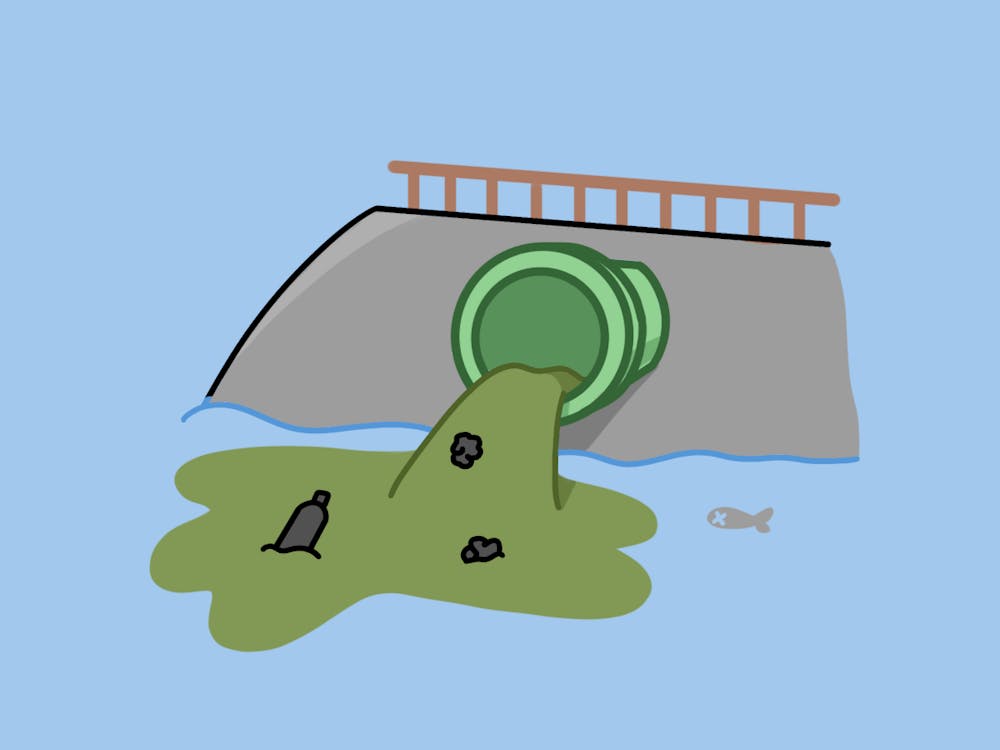For most Americans, the natural assumption is that when they flush their toilet, the waste disappears into a tightly managed and regulated system. Beneath our cities, vast pipes snake out and flow into wastewater treatment plants, keeping our environment safe from the toxic waste that vanishes into the underground network. This assumption hides one of the greatest environmental scandals in American history.
Under the watchful eye of the EPA, a toxic stew of industrial and human waste has been spread into the water and food supply. This practice has been normalized, legalized and mandated. They have the gall to call this “eco-friendly.”
It is a willfully indifferent contamination of the American landscape on a scale that may be irreversible. Every city collects sewage, combining residential excrement with industrial waste from factories, hospitals, and other commercial operations. At treatment plants, the liquids and solids are separated. After varying degrees of processing, the water is released into the rivers and oceans, but the solids–the concentrated mix of everything flushed down every drain–become what are politely referred to as “biosolids.”
“Biosolids” are nothing more than sewage sludge, packed with the remnants of pharmaceuticals, pesticides, solvents, plastics, heavy metals, pathogens and whatever else the industrial corporations are allowed to pour into municipal waste systems.
Treatment plants remove these contaminants from the water supply, where they are then dried, pelletized, bagged and sold as fertilizer. Gardeners buy it, farmers spread it on their fields, and the process is endorsed as sustainable recycling, while only a select few realize that they are eating food grown in a concoction that might be the most polluted waste mixture of the 21st century.
The Environmental Protection Agency (EPA) regulates water and air through the Clean Water Act and the Clean Air Act. However, there is no Clean Soil Act. That absence created a vacuum where some of the most dangerous pollutants imaginable could be legally dumped into the Earth without restriction.
In the late 1990s, the EPA, struggling with the growing challenge of what to do with mountains of sewage sludge, approved the land application of the sewage, selling it to independent farmers as an eco-friendly, affordable option at a lower cost than other natural fertilizers.
Additionally, chemical producing plants were not only permitted, but required by law to dump hazardous waste into sewers, where it would be absorbed into the sludge. From there, the material could be repackaged, marketed as fertilizer, and spread far and wide. What should have been disposed of as hazardous waste became the foundation of America’s agricultural industry, and the public never questioned it.
The concept of recycling sewage naturally appeals to the modern sense of green environmental stewardship. Why should we waste the organic matter when it could be returned to the soil? The answer lies in what else is mixed in with the “organic matter.”
Every mixture of drugs flushed out of a hospital, every solvent poured down a factory drain, every pesticide washed off a suburban lawn into storm drains and every microplastic fragment collected from urban runoff; all of it enters the wastewater stream. These substances aren’t eliminated, only shifted into biosolids.
They are then sold to unsuspecting local farmers and the agricultural industry as a whole, where the crops absorb the toxic residue. Rain carries the pollutants further into rivers and lakes, and the “grass-fed livestock” eats the grass grown on contaminated fields. The very same waste that you flushed down the drain returns weeks later on your dinner plate.
Beyond the concerns of toxic chemicals, sewage sludge contains an array of infectious agents: bacteria, viruses, fungi and parasites. With the concerning rise of antibiotic superbugs, spreading these biosolids on farmland creates a perfect distribution system for organisms that modern medicine will be increasingly powerless against.
Imagine just one city where a particularly contaminated batch of biosolids is applied to a field. Flies land on the field and then move into nearby homes and restaurants. Birds eat the contaminated insects and migrate, the wind scatters dried particles, and that batch of crops grow in soil infused with pathogens.
Now multiply that by a thousand municipalities, and you get an idea of the potential of the vast dispersal of infectious material into the environment.
Even setting aside natural pathogens and pandemics, in an age of increasing global instability and terrorism, it would be all too easy for anyone with access to sewer lines to deposit harmful substances, either biological or chemical, that could move through the system and be spread across wide regions.
Visit your average garden supply store and you’ll find various examples of repackaged biosolids. “Dillo Dirt” and “Milorganite” are two such brands, described as eco-friendly and approved for use on lawns, gardens and even food crops (the fine print reads for animal use only).
However, “Dillo Dirt” is just repackaged sewage from the city of Austin and the brand “Milorganite” takes its biosolids from the waste of Milwaukee. Advertising the repackaged sewage as “organic” and “green” is grotesquely ironic. This is a nationwide issue across a variety of fertilizer brands.
Despite the scale of the problem, the biosolids issue remains largely invisible to the general public. If you were to pull a person off the streets of New York and ask them where their sewage goes, most of them would say “into treatment plants” or “out to sea”. Very few know that hundreds of thousands of tons of biosolid sludge are shipped by train to rural states and spread across agricultural fields to grow food that is later shipped back to the city.
Meanwhile, the large corporations and the government municipalities benefit from the public ignorance, painting the appearance of environmental responsibility while profiting off of selling hazardous waste.
The media, for their part, dominates the Green conversation with debates over climate change and combating carbon emissions, while rarely discussing the uncomfortable truth of what follows the flush.
The consequences of their actions quietly accumulate beneath our unsuspecting feet as heavy metals, synthetic chemicals, and pathogens fester in our soil, outlasting us and our future generations, leaving behind a poisoned legacy that our grandchildren’s children will inherit long after we are buried amongst the biosolids. A poisoned legacy built under the enabling eye of the EPA.
To find the root of this issue, we have to take a look at the EPA itself. When it was created in 1970, it was a moment of hope for a burdened America. Our cities were choking on pollution, our rivers were so toxic they were catching fire, and a combination of smog and pesticides were wiping out bird populations.
The EPA brought in an independent body of scientists and regulators dedicated to protecting air, water, and land, and for a time, it worked. But like any government agency, the EPA became vulnerable to political pressure.
By the early 1990s, a cultural shift had taken place inside the organization. Many of the scientists who had been with the EPA since its infancy left in frustration, replaced by a new generation more focused on corporate interests. They switched from following peer reviewed evidence to working alongside big corporate industries to work out agreements in exchange for selectively collected data and skewed studies.
The EPA faced a mounting waste problem. Wastewater treatment plants across the country were producing millions of tons of sludge each year. Dumping it into the ocean was politically and environmentally untenable. Landfilling and incineration were both costly and required both energy and additional infrastructure, so they began searching for a cheaper solution.
The answer was found in a set of policies known as the “503 rules”, named after Section 503 of the Clean Water Act.
These rules reclassified sewage sludge as a beneficial substance, safe for application to farmland as a fertilizer. With the stroke of a pen, the most contaminated byproduct of modern society was transformed into an eco-friendly benefit.
The growing corruption at the EPA festered as the years went on, spanning multiple administrations as they attempted to silence whistleblowers and rewarded the biosolid defenders with promotions and presidential commendations.
Take, for example, the story of Dr. David Lewis, a former senior scientist at the EPA. Lewis began raising concerns about the health effects of land-applied sludge in the 1990s and spoke out about finding evidence of contamination, disease outbreaks, and manipulated data. Instead of being commended, his career was destroyed, and he was blacklisted from the industry.
Beyond legalizing the sewer sludge, the EPA delegated responsibility for regulation to state agencies, giving them the authority to lower standards even further.
The state departments of ecology and agriculture were eager to support local farmers and reduce costs, and welcomed the chance to use the biosolids as free fertilizer. The municipalities, desperate to rid themselves of mountains of waste, were more than happy to comply.
This all resulted in a complicated system of corporate malfeasance, governmental corruption, and the leasing out of waste disposal through government contracts. The counties signed contracts with large sludge disposal corporations, backed by strong legal teams and powerful lobbying groups.
Any attempt to change the status quo was met with resistance, lawsuits, and increasing political pressure. For the sludge itself, the testing standards are shockingly low. Only a small handful of chemicals and pathogens are regularly monitored, even though independent studies have identified tens of thousands of contaminants.
In one well-documented sample from Milwaukee, over 3,500 distinct chemical candidates were identified. In another, from Austin, nearly 2,000 chemicals were found. Admittedly, chemical is a broad term encompassing a variety of materials, but these were not harmless compounds.
The discovered chemicals included herbicides like atrazine and pharmaceuticals like warfarin, pesticides, solvents, and hormone disruptors. These are only the chemicals that independent scientists have been able to detect in limited tests.
Across America, biosolids are estimated to contain over 80,000 chemical substances, with a thousand new synthetics introduced every year. Many are poorly studied, and very few have been evaluated for their long term effects when combined with other chemicals in the sewage stream.
Under a microscope, these biosolid pellets show telltale signs of microplastics. These do not degrade and will remain in our soil for millennia. These tests also revealed large quantities of heavy metals like cadmium, lead, and mercury in the biosolids, all which will never disappear from our environment.
None of the concoctions mixed in this sewage sludge, made up of antihistamines, antibiotics, hormone therapies, painkillers, and antidepressants, were made to be consumed through food. This deadly combination of plastics, metals, and pharmacia is part and parcel of biological problems across America, such as declining fertility rates, shifting hormone balances across men and women, and a general weakening of immune systems.
Other nations have already taken the first steps toward solving this problem. After a wave of public backlash from its citizens, Switzerland outlawed the application of biosludge. Germany and Scandinavia invested in thermal conversion processes that aided in neutralizing the toxins. The United States has access to the very same technologies. The only thing missing is the will to change.
The creation and spread of biosolids is the greatest environmental crime America has ever faced. It touches every aspect of our lives and does so silently, invisibly, and legally. It persists not because it must, but because we have allowed it with our silence.
Silence is the greatest accomplice to this crime.
Only when the silence ends can the healing begin.
Do you like this story? The Plainsman doesn't accept money from tuition or student fees, and we don't charge a subscription fee. But you can donate to support The Plainsman.
Logan Myers, freshman majoring in journalism, is from Hilton Head Island, South Carolina. He has been with The Auburn Plainsman since the fall of 2025. In his spare time, he writes short stories and novels in the horror/thriller genre and enjoys camping.





